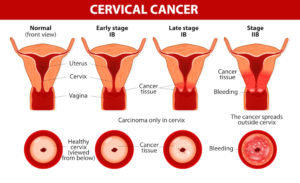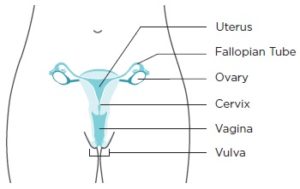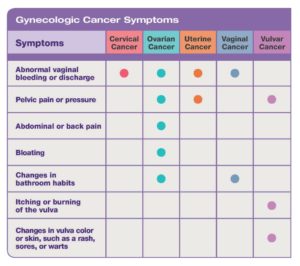According to the CDC, uterine cancer (cancer which develops in the uterus) is the most commonly diagnosed gynecological cancer in the U.S. and the fourth most common cancer in U.S. women overall.
Types of Gynecological Cancer
- Cervical cancer.
- Ovarian cancer.
- Uterine cancer.
- Vaginal cancer.
- Vulvar cancer.
September is Gynecologic Cancer Awareness
It is estimated that within the past 2 years 98,000 women would be diagnosed with a gynecologic cancer and some 30,000 would die from the disease.
Gynecological Cancer Awareness Month provides an important opportunity to draw attention to this important women’s health issue and offer vital information on risk cancers, warning signs, and prevention strategies.
Uterine Cancer
Uterine cancer forms in the tissues of the uterus, the organ in which a fetus develops. The two types of uterine cancer are endometrial cancer and uterine sarcoma.
Endometrial cancer forms in the tissues of the endometrium – the lining of the uterus. Obesity, high blood pressure, and diabetes may increase the risk of endometrial cancer.
Uterine Sarcoma is a rare type of cancer that forms in the uterine muscles or in tissues that support the uterus. Exposure to X-rays during radiation therapy can increase the risk of uterine sarcoma.
Treatment with the breast cancer drug tamoxifen is a risk factor for both types of uterine cancer.
According to the CDC, uterine cancer (cancer which develops in the uterus) is the most commonly diagnosed gynecological cancer in the U.S. and the fourth most common cancer in U.S. women overall. While any woman can develop uterine cancer, it is most commonly diagnosed in women who have gone through menopause. Risk factors for uterine cancer include age (being age 50 or older), obesity, taking estrogen alone as hormone replacement, and having a family history of uterine, ovarian or colon cancer.
Routine testing is not recommended for uterine cancer, so it is important for women to be aware of symptoms—such as abnormal vaginal discharge or bleeding and/or pain and pressure in the pelvic area—and talk to a healthcare provider if they experience these.
Ovarian Cancer
While ovarian cancer accounts for about 3% of cancers among women, it causes more deaths than any other gynecological cancer, according to the American cancer Society. While the survival rates for ovarian cancer are excellent when the disease is diagnosed early, only about 20% of ovarian cancers are found at this early stage. One reason for this is that there is no recommended routine screening for ovarian cancer on women without symptoms. And the symptoms of ovarian cancer—including abnormal abdominal bloating, abdominal pain or pressure, and feeling full quickly when eating—can also be easily be ignored or mistaken for other problems.
For women who experience these symptoms, or who at at higher risk (including women who have had breast cancer or have a family history of ovarian, breast or colorectal cancer), a healthcare provider may recommending further screening. Testing may include rectovaginal pelvic exam, a transvaginal ultrasound,or a CA-125 blood test.
There are three types of ovarian cancer in adults, including ovarian epithelial cancer, which begins in the tissue covering the ovary, lining of the fallopian tube, or the peritoneum; ovarian germ cell tumors, which start in the egg or germ cells; and ovarian low malignant potential tumors, which begin in the tissue covering the ovary.
Cervical Cancer
According to the American Sexual Health Organization, the vast majority of cases of cervical cancer—cancer that develops on the cervix, the opening to the uterus—are linked to human papillomavirus (HPV) infection. The majority of women with an HPV infection will not develop cervical cancer, but regular screening is essential. In most cases cervical cancer can be prevented through early detection and treatment of abnormal cell changes that occur in the cervix years before cervical cancer develops. These changes are typically detected through a Pap test or an HPV test. HPV vaccines can also prevent cervical cancer.
In its early stages, cervical cancer typically doesn’t have any symptoms, which is why regular screening is so important. At later stages, symptoms may include abnormal vaginal discharge or bleeding or pain during sex. While these can also be signs of other health issues, if a woman experiences these symptoms, she should report them to her healthcare provider.

Cervical Cancer. Carcinoma of Cervix. Malignant neoplasm arising from cells in the cervix uteri. Vaginal bleeding. Vector diagram
Vaginal and Vulvar Cancer
There are two main types of vaginal cancer: squamous cell carcinoma and adenocarcinoma. Adenocarcinoma is more likely than squamous cell cancer to spread to the lungs and lymph nodes. A rare type of adenocarcinoma is linked to being exposed to diethylstilbestrol (DES) before birth.
Adenocarcinomas not linked with being exposed to DES are most common in women after menopause.
According to the American Sexual Health Organization, vaginal and vulvar cancers are rare—an estimated 1,000 women are diagnosed with vaginal cancer and 3,500 women with vulvar cancer each year. Like cervical cancer, vaginal and vulvar cancers are also associated with HPV infection, with up to 90% of vaginal cancers and pre-cancers and more than 50% of vulvar cancers linked to infection with the high-risk HPV types.
Vulvar cancer forms in a woman’s external genitalia. Vulvar cancer most often affects the outer vaginal lips.
Abnormal cells can grow on the surface of the vulvar skin for a long time. This condition is called vulvar intraepithelial neoplasia (VIN). Because it is possible for VIN to become vulvar cancer, it is important to get treatment.
Risk factors for vulvar cancer include having VIN, HPV infection, and having a history of genital warts.
HPV vaccines, which prevent some of the high-risk types of HPV, can also help prevent vaginal and vulvar cancers.


